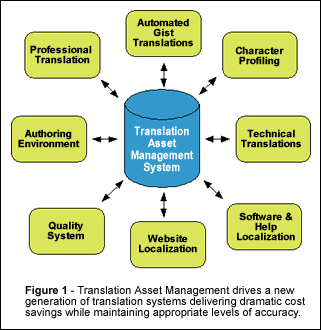Are you making the most of your translation assets?
Efficiency and low overheads are things that most businesses strive hard to achieve. So you’d expect that most businesses would have a pretty good handle on how much time and money they spend on translations. In our experience however, it is often the case that companies find it difficult to audit their expenditure due the fragmented nature of translation purchasing. Some don’t real ise they translate anything at all, and many are losing out completely on the potential of the translations they do commission.
When we question companies closely, we find that where translations are commissioned internally, the work is often funded from many different departments’ budgets. Translating the documentation once and making the translated copies easily accessible to other branch offices achieved significant savings.
Translation Asset Management is the key to success
Every time you commission a translation you are paying for a valuable asset that has the potential to be re-used repeatedly throughout your company for years to come.
Many enterprises have made a start by using translation memory to build their translation assets. Unfortunately these translation assets are frequently inaccessible and are stored in various locations throughout the enterprise and their suppliers. There are usually several versions floating around, none exactly the same. Nobody knows which the latest is or if the final edits to the last job are reflected in the translation memory. And even then, translation memory is usually stored in a flat file making it impossible to utilize translation memory fully as an asset.
WorldLingo’s Translation Asset Management System™ takes these existing translation assets stores them in a powerful database that is accessible to the entire enterprise, both as a resource and a tool. These assets include:
- Pre-Existing Translations
- Translation memories
- Glossaries
- Terminology databases
- 'Do not translate' lists
- Localized Multimedia - graphics, pictures, diagrams, video, sound bites and other complex elements.
- Specialized machine translation engines
- Style guidelines
- Character profiles
The Translation Asset Management is the central core that allows your enterprise to take advantage of the following translation solutions – which are configured and customized to meet the translation and communication needs of your enterprise.

The system detects which translations you already have and enables you to re-use them quickly and easily for new human translation projects or enhanced automated translations. As a result, future translations will be cheaper to produce and will also benefit from consistency because they derive from the same original translations.
WorldLingo's TAMS™ (Translation Asset Management System™) is nearing release and is currently undergoing beta testing. It has the following objectives:
- To ensure ownership of the translation asset,
- To ensure possession of the translation asset,
- To provide high availability of the translation asset to users,
- To handle very large volume translation assets,
- To be able to drill down to serve specialist subsets of the translation asset,
- To allow users access to the translation asset for the purpose of having the document translated as requested, but not allowing a valuable corporate asset to be pilfered, and
- To provide the foundation for a variety of specialized translation solutions.
If your organization would like to participate in the beta program to gain first hand experience in the effective management of translation assets, then please request a beta slot for your organization.
